
Pallet
Encyclopedia
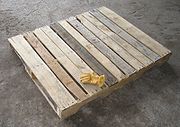

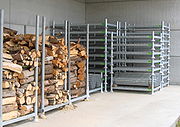
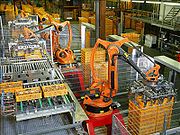
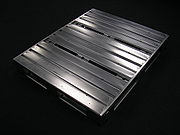
Pallet jack
A pallet jack, also known as a pallet truck, pump truck, or jigger is a tool used to lift and move pallets.The front wheels are mounted inside the end of the forks, and as the hydraulic jack is raised, the forks are separated vertically from the front wheels, forcing the load upward until it clears...
, front loader
Loader (equipment)
A loader is a heavy equipment machine often used in construction, primarily used to load material into or onto another type of machinery .-Heavy equipment front loaders:A loader A loader is a heavy equipment machine often used in construction, primarily used to load material (such as asphalt,...
or other jacking device
Jack (mechanical)
A jack is a mechanical device used to lift heavy loads or apply great forces. Jacks employ a screw thread or hydraulic cylinder to apply very high linear forces.-Mechanical jack:...
. A pallet is the structural foundation of a unit load
Unit load
A unit load combines individual items or items in shipping containers into a single "unit" that can be moved easily with pallet jack or forklift truck...
which allows handling and storage efficiencies. Goods or shipping container
Shipping container
A shipping container is a container with strength suitable to withstand shipment, storage, and handling. Shipping containers range from large reusable steel boxes used for intermodal shipments to the ubiquitous corrugated boxes...
s are often placed on a pallet secured with strapping
Strapping
Strapping, also known as bundling and banding, is the process of applying a strap to an item to combine, hold, reinforce, or fasten it. The strap may also be referred to as strapping...
, stretch wrap
Stretch wrap
Stretch wrap or stretch film is a highly stretchable plastic film that is wrapped around items. The elastic recovery keeps the items tightly bound...
or shrink wrap
Shrink wrap
Shrink wrap, also shrinkwrap or shrink film, is a material made up of polymer plastic film. When heat is applied it shrinks tightly over whatever it is covering. Heat can be applied with a hand held heat gun or the product and film can pass through a heat tunnel on a conveyor.-Composition:The...
and shipped.
While most pallets are wood
Wood
Wood is a hard, fibrous tissue found in many trees. It has been used for hundreds of thousands of years for both fuel and as a construction material. It is an organic material, a natural composite of cellulose fibers embedded in a matrix of lignin which resists compression...
en, pallets also are made of plastic
Plastic
A plastic material is any of a wide range of synthetic or semi-synthetic organic solids used in the manufacture of industrial products. Plastics are typically polymers of high molecular mass, and may contain other substances to improve performance and/or reduce production costs...
, metal
Metal
A metal , is an element, compound, or alloy that is a good conductor of both electricity and heat. Metals are usually malleable and shiny, that is they reflect most of incident light...
, and paper
Paper
Paper is a thin material mainly used for writing upon, printing upon, drawing or for packaging. It is produced by pressing together moist fibers, typically cellulose pulp derived from wood, rags or grasses, and drying them into flexible sheets....
. Each material has advantages and disadvantages relative to the others. (See the sections "Phytosanitary compliance" and "Materials used" below.)
Overview
ContainerizationContainerization
Containerization is a system of freight transport based on a range of steel intermodal containers...
for transport has spurred the use of pallets because the shipping containers
Intermodal container
An intermodal container is a standardized reusable steel box used for the safe, efficient and secure storage and movement of materials and products within a global containerized intermodal freight transport system...
have the clean, level surfaces needed for easy pallet movement. Most pallets can easily carry a load of 1000 kg (2,205 lb). Today, over half a billion pallets are made each year and about two billion pallets are in use across the United States
United States
The United States of America is a federal constitutional republic comprising fifty states and a federal district...
alone.
Pallets make it easier to move heavy stacks. Loads with pallets under them can be hauled by forklift trucks of different sizes, or even by hand-pumped and hand-drawn pallet jack
Pallet jack
A pallet jack, also known as a pallet truck, pump truck, or jigger is a tool used to lift and move pallets.The front wheels are mounted inside the end of the forks, and as the hydraulic jack is raised, the forks are separated vertically from the front wheels, forcing the load upward until it clears...
s. Movement is easy on a wide, strong, flat floor: concrete is excellent. A forklift truck can cost the same as a luxury automobile, but a good reconditioned hand-drawn pallet jack costs only a few hundred dollars. The greatest investment is thus in the construction of commercial or industrial buildings where the use of pallets could be economical. Passage through doors and buildings must be possible. To help this issue, some later pallet standards (the europallet and the U.S. Military 35 ×) are designed to pass through standard doorways.
Organizations using standard pallets for loading and unloading can have much lower costs for handling and storage, with faster material movement than businesses that do not. The exceptions are establishments that move small items such as jewelry or large items such as cars. But even they can be improved. For instance, the distributors of costume jewelry
Costume jewelry
Costume jewelry is jewelry manufactured as ornamentation to complement a particular fashionable costume or garment. Costume jewelry came into being in the 1930s as a cheap, disposable accessory meant to be worn with a specific outfit...
normally use pallets in their warehouse
Warehouse
A warehouse is a commercial building for storage of goods. Warehouses are used by manufacturers, importers, exporters, wholesalers, transport businesses, customs, etc. They are usually large plain buildings in industrial areas of cities and towns. They usually have loading docks to load and unload...
s and car manufacturers use pallets to move components and spare parts.
The lack of a single international standard for pallets causes substantial continuing expense in international trade. A single standard is difficult because of the wide variety of needs a standard pallet would have to satisfy: passing doorways, fitting in standard containers, and bringing low labor costs. For example, organizations already handling large pallets often see no reason to pay the higher handling cost of using smaller pallets that can fit through doors.
Due to cost and a need to focus on corebusiness pallet pooling becomes more and more common. Some pallet suppliers supply users with reusable pallets, sometimes with integral tracking devices. A pallet management company can help supply, clean, repair, and reuse pallets.
History
Dimensions
In a pallet measurement the first number is the stringer length and the second is the deckboard length. Square or nearly square pallets help a load resist tipping.Two-way pallets are designed to be lifted by the deckboards. In a warehouse the deckboard side faces the corridor. For optimal cubage in a warehouse, the deckboard dimension should be the shorter. This also helps the deckboards be more rigid.
Four-way pallets, or pallets for heavy loads, or general-purpose systems that might have heavy loads are best lifted by their more rigid stringers. A warehouse has the stringer side facing the corridor. For optimal cubage in a warehouse, the stringer dimension should be the shorter.
Pallet users want pallets to easily pass through buildings, stack and fit in racks
Warehouse
A warehouse is a commercial building for storage of goods. Warehouses are used by manufacturers, importers, exporters, wholesalers, transport businesses, customs, etc. They are usually large plain buildings in industrial areas of cities and towns. They usually have loading docks to load and unload...
, forklifts, pallet jack
Pallet jack
A pallet jack, also known as a pallet truck, pump truck, or jigger is a tool used to lift and move pallets.The front wheels are mounted inside the end of the forks, and as the hydraulic jack is raised, the forks are separated vertically from the front wheels, forcing the load upward until it clears...
s and automated warehouse
Warehouse
A warehouse is a commercial building for storage of goods. Warehouses are used by manufacturers, importers, exporters, wholesalers, transport businesses, customs, etc. They are usually large plain buildings in industrial areas of cities and towns. They usually have loading docks to load and unload...
s. To avoid shipping air, pallets should also pack tightly inside intermodal container
Intermodal container
An intermodal container is a standardized reusable steel box used for the safe, efficient and secure storage and movement of materials and products within a global containerized intermodal freight transport system...
s and vans.
No universally accepted standards for pallet dimensions exist. Companies and organizations utilize hundreds of different pallet sizes around the globe. While no single dimensional standard governs pallet production, a few different sizes are widely used.
ISO pallets
The International Organization for StandardizationInternational Organization for Standardization
The International Organization for Standardization , widely known as ISO, is an international standard-setting body composed of representatives from various national standards organizations. Founded on February 23, 1947, the organization promulgates worldwide proprietary, industrial and commercial...
(ISO) sanctions six pallet dimensions, detailed in ISO Standard 6780: Flat pallets for intercontinental materials handling—Principal dimensions and tolerances:
| Dimensions, mm (W × L) | Dimensions, in (W × L) | Wasted floor, ISO container | Region most used in |
|---|---|---|---|
| 1219 × 1016 | 48.00 × 40.00 | 11.7% (20 pallets in 40ft ISO) | North America |
| 1000 × 1200 | 39.37 × 47.24 | 6.7% | Europe, Asia; similar to 48x40". |
| 1165 × 1165 | 45.87 × 45.87 | 8.1% | Australia |
| 1067 × 1067 | 42.00 × 42.00 | 11.5% | North America, Europe, Asia |
| 1100 × 1100 | 43.30 × 43.30 | 14% | Asia |
| 800 × 1200 | 31.50 × 47.24 | 15.2% | Europe; fits many doorways |
North American pallets
Of the top pallets used in North America, the most commonly used by far is the Grocery Manufacturers' Association (GMA) pallet, which accounts for 30% of all new wood pallets produced in the United States. The ISO also recognizes the GMA pallet footprint as one of its six standard sizes.| Dimensions, mm (W × L) | Dimensions, in (W × L) | Production Rank | Industries Using |
|---|---|---|---|
| 1219 × 1016 | 48 × 40 | 1 | Grocery, many others |
| 1067 ×1067 | 42 × 42 | 2 | Telecommunications, Paint |
| 1219 × 1219 | 48 × 48 | 3 | Drums |
| 1016 × 1219 | 40 × 48 | 4 | Military, Cement |
| 1219 × 1067 | 48 × 42 | 5 | Chemical, Beverage |
| 1016 × 1016 | 40 × 40 | 6 | Dairy |
| 1219 × 1143 | 48 × 45 | 7 | Automotive |
| 1118 × 1118 | 44 × 44 | 8 | Drums, Chemical |
| 914 × 914 | 36 × 36 | 9 | Beverage |
| 1219 × 914 | 48 × 36 | 10 | Beverage, Shingles, Packaged Paper |
| 889 × 1156 | 35 × 45.5 | Unknown | Military 1/2 ISO container, fits 36" standard doors |
| 1219 × 508 | 48 × 20 | Unknown | Retail |
European pallets
In Europe, the EURO pallet, also called a CENEuropean Committee for Standardization
The European Committee for Standardization or Comité Européen de Normalisation , is a non-profit organisation whose mission is to foster the European economy in global trading, the welfare of European citizens and the environment by providing an efficient infrastructure to interested parties for...
pallet, is widely used in many industries. It measures 800 by 1200 by 144 mm. Manufacturers of EURO pallets must be sanctioned by the European Pallet Association (EPAL), which governs the smallest details, even which types of nails and lumber may be used. The strict standardization is based on the existence of europool pallet swap organizations - their mutual swap agreements across country boundaries only include EURO pallets of a specific EPAL/EUR type (mostly restricted to type 1). Most freight forwarder
Freight forwarder
A freight forwarder, forwarder, or forwarding agent is a person or company that organizes shipments for individuals or other companies and may also act as a carrier...
s will accept pool pallets, handling the cost clearing between sender and receiver even for international transport to countries that take part in the europool system. The ongoing harmonization of freight handling within the European Economic Area
European Economic Area
The European Economic Area was established on 1 January 1994 following an agreement between the member states of the European Free Trade Association and the European Community, later the European Union . Specifically, it allows Iceland, Liechtenstein and Norway to participate in the EU's Internal...
has led to a decline of the europool system. The EURO pallet does not fit efficiently within the ISO shipping container
Intermodal container
An intermodal container is a standardized reusable steel box used for the safe, efficient and secure storage and movement of materials and products within a global containerized intermodal freight transport system...
and slightly wider containers are often used for this reason.
The four common sizes of EURO pallets (alongside with ISO alternative sizes) are:
| EURO pallet type | Dimensions, mm/in (W × L) | ISO pallet alternative |
|---|---|---|
| EUR, EUR 1 | 800 × | ISO1, same size as EUR |
| EUR 2 | 1200 × | ISO2 |
| EUR 3 | 1000 × | |
| EUR 6 | 800 × | ISO0, half the size of EUR |
| 600 × | quarter the size of EUR | |
| 400 × | one-eighth the size of EUR |
Australian Standard Pallets
The Australian Standard Pallet is a pallet size commonly found in Australia but found rarely elsewhere. It is a square hardwood pallet 1165 by in size which fits perfectly in the RACE containerRACE (container)
Railways of Australia Container Express or RACE was a slightly wider version of the standard ISO shipping container able to take 2 Australia Standard Pallets side by side...
of the Australian Railway, but is ill suited to fitting in the standard ISO containers used around the globe. However, with two Australian pallets side-by-side, there is still 22 mm (0.866141732283465 in) "spare". If the pallets are loaded correctly (without any overhang), this means there is an average of 7 mm in between the container wall, the pallets and the opposite container wall. While this is a tight fit, it means there is less need for dunnage (stuffing) between the container walls and the pallets.
Australia also requires more stringent import standards than the globally accepted ISPM 15
ISPM 15
International Standards For Phytosanitary Measures No. 15 is an International Phytosanitary Measure developed by the International Plant Protection Convention that directly addresses the need to treat wood materials of a thickness greater than 6mm, used to ship products between countries...
wood packaging material regulations. Australia requires the wood packaging material used for international shipping to be completely bark free.
Standard-setting organizations
A number of different organizations and associations around the world work towards establishing and promulgating standards for pallets. Some strive to develop universal standards for pallet dimensions, types of material used in construction, performance standards, and testing procedures. Other organizations choose to focus on pallet standards for a specific industry (such as the groceries) or type of material (such as wood).ISO Technical Committee 51: Pallets for unit load method of materials handling
ISO TC 51 states its scope of work entailing the "standardization of pallets in general use in the form of platforms or trays on which goods may be packed to form unit loads for handling by mechanical devices". The Technical Committee works in conjunction with other Technical Committees focused on transportation infrastructure to develop interrelated standards. TC 51 is responsible for developing ISO Standard 6780: Flat pallets for intercontinental materials handling—Principal dimensions and tolerances as well as sixteen other standards related to pallet construction and testing.National Wood Pallet and Container Association
The National Wood Pallet and Container Association (NWPCA) is a trade organization based in the United States devoted to representing the interests of wood pallet and container manufacturers. The NWPCA defines its mission as helping its membership create cost-effective, environmentally friendly solutions to customers' needs. Towards that end, the NWPCA developed a bevy of resources to assist its membership, including the Pallet Design System (PDS), which allows users to develop and analyze pallet designs.U.S. DOD, Dept. of Navy, Naval Sea Systems Command
This organization maintains MIL-STD-1660, the standard description of palletized unit loadUnit load
A unit load combines individual items or items in shipping containers into a single "unit" that can be moved easily with pallet jack or forklift truck...
s for the U.S. Military and some allies.
DOD Unit loads generally use 40 by 48 in (1,016 by 1,219.2 mm) pallets, are less than 4000 lb (1,814 kg), weatherproof, and stack 16 ft (4.88 m) high. They often use steel pallets, steel straps with notched seals, outdoor plywood, and plastic film. The standard describes tests for stacking, transport, sling, forklift and pallet jack, impact, drop tests, tip, water-retention, and disassembly.
European Committee for Standardization (Comité Européen de Normalisation)
In addition to the other standards it publishes, the European Committee for StandardizationEuropean Committee for Standardization
The European Committee for Standardization or Comité Européen de Normalisation , is a non-profit organisation whose mission is to foster the European economy in global trading, the welfare of European citizens and the environment by providing an efficient infrastructure to interested parties for...
, also known as the Comité Européen de Normalisation (CEN), produces standards for pallets. While the standards are voluntary in nature, many companies and organizations involved in transportation have adopted them. The major standard for pallets produced by CEN is ICS: 55.180.20 General purpose pallets
Phytosanitary Compliance
Due to the International Plant Protection ConventionInternational Plant Protection Convention
The International Plant Protection Convention is an international treaty organization that aims to secure coordinated, effective action to prevent and to control the introduction and spread of pests of plants and plant products. The Convention extends beyond the protection of cultivated plants to...
(abbreviated IPPC), most pallets shipped across national borders must be made of materials that are incapable of being a carrier of invasive species
Invasive species
"Invasive species", or invasive exotics, is a nomenclature term and categorization phrase used for flora and fauna, and for specific restoration-preservation processes in native habitats, with several definitions....
of insects and plant diseases. The standards for these pallets is specified in ISPM 15
ISPM 15
International Standards For Phytosanitary Measures No. 15 is an International Phytosanitary Measure developed by the International Plant Protection Convention that directly addresses the need to treat wood materials of a thickness greater than 6mm, used to ship products between countries...
.
Pallets made of raw, untreated wood are not compliant with ISPM 15. To be compliant the pallets (or other wood packaging material) must meet debarked standards, and must be treated by either of the following means under the supervision of an approved agency:
- Heat treatment The wood must be heated to achieve a minimum core temperature of 56 °C (132.8 °F) for at least 30 minutes. Pallets treated via this method bear the initials HT near the IPPC logo.
- Chemical fumigationFumigationFumigation is a method of pest control that completely fills an area with gaseous pesticides—or fumigants—to suffocate or poison the pests within. It is utilized for control of pests in buildings , soil, grain, and produce, and is also used during processing of goods to be imported or...
The wood must be fumigated with methyl bromide. Pallets treated via this method bear the initials MB near the IPPC logo. From 19 March 2010 the use of Methyl Bromide as an acceptable treatment according to ISPM15 has now been phased out.
Pallets made of non-wood materials such as steel
Steel
Steel is an alloy that consists mostly of iron and has a carbon content between 0.2% and 2.1% by weight, depending on the grade. Carbon is the most common alloying material for iron, but various other alloying elements are used, such as manganese, chromium, vanadium, and tungsten...
, aluminum, plastic
Plastic
A plastic material is any of a wide range of synthetic or semi-synthetic organic solids used in the manufacture of industrial products. Plastics are typically polymers of high molecular mass, and may contain other substances to improve performance and/or reduce production costs...
, or engineered wood
Engineered wood
Engineered wood, also called composite wood, man-made wood, or manufactured board; includes a range of derivative wood products which are manufactured by binding the strands, particles, fibers, or veneers of wood, together with adhesives, to form composite materials...
products, such as plywood
Plywood
Plywood is a type of manufactured timber made from thin sheets of wood veneer. It is one of the most widely used wood products. It is flexible, inexpensive, workable, re-usable, and can usually be locally manufactured...
, oriented strand board
Oriented strand board
Oriented strand board, also known as OSB and SmartPly , is an engineered wood product formed by layering strands of wood in specific orientations. In appearance, it may have a rough and variegated surface with the individual strips Oriented strand board, also known as OSB (UK) and SmartPly (UK &...
, or corrugated fiberboard do not need IPPC approval, and are considered to be exempt from ISPM 15 regulations.
Types of pallets
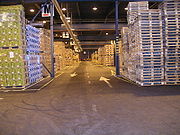
Stringer pallet
Stringer pallets use a frame of three or four parallel pieces of timber (called stringers). The top deckboards are then affixed to the stringers to create the pallet structure. Stringer pallets are also known as "two-way" pallets, since a pallet-jack may only lift it from two directions instead of four. Forklifts can lift a stringer pallet from all four directions, though lifting by the stringers is more secure.Block pallet
Block pallets (also referred to as Manoj pallets) are typically stronger than stringer pallets. Block pallets utilize both parallel and perpendicular stringers to better facilitate efficient handling. A block pallet is also known as a "four-way" pallet, since a pallet-jack may be used from any side to move it.Perimeter base pallet
All stringer and some block pallets have "unidirectional bases," i.e. bottom boards oriented in one direction. While automated handling equipment can be designed for this, often it can operate faster and more effectively if the bottom edges of a pallet have bottom boards oriented in both directions. For example, it may not need to turn a pallet to rack it, and operation is less sensitive to pallet orientation.Quality improvements
The least expensive way to improve a pallet is usually to specify better nails. With non-wood pallets, a controlled coefficient of friction is often helpful to prevent the pallet from slipping from forks and racks. Stiffer pallets are more durable, and are handled more easily by automated equipment. If a pallet does not need to be lifted from all four sides, two-way pallets with unnotched stringers may be used, with the additional benefits of added rigidity and strength. Specifying tolerances on flatness and water content may help the supplier meet target requirements. Inspection of pallets, whether in person or by a third-party (such as "SPEQ" inspected pallets) offer additional assurance of quality.Materials used
.jpg)
Softwood
The term softwood is used to describe wood from trees that are known as gymnosperms.Conifers are an example. It may also be used to describe trees, which tend to be evergreen, notable exceptions being bald cypress and the larches....
and are often considered expendable, to be discarded as trash along with other wrapping elements, at the end of the trip. These pallets are simple stringer pallets, and liftable from two sides.
Slightly more complex hardwood
Hardwood
Hardwood is wood from angiosperm trees . It may also be used for those trees themselves: these are usually broad-leaved; in temperate and boreal latitudes they are mostly deciduous, but in tropics and subtropics mostly evergreen.Hardwood contrasts with softwood...
block pallets, plastic pallets and metal pallets can be lifted from all four sides. These costlier pallets usually require a deposit and are returned to the sender or resold as used. Many "four way" pallets are color coded according to the loads they can bear, and other attributes.
Wooden pallet construction specifications can depend on the pallet's intended use: general, FDA, storage, chemical, export; the expected load weight; type of wood desired: recycled, hard, soft, kiln dried or combo (new & recycle); and even the type of fasteners desired to hold the pallet together: staples or nails.
Paper pallets
Paper pallet
Paper pallets are shipping or display pallets made from paperboard.-Construction:Paper shipping pallets come in corrugated fiberboard, partial wood decks or engineered with laminated paperboard...
are often used for light loads, but engineered paper pallets are increasingly used for loads that compare with wood. Paper
Paper
Paper is a thin material mainly used for writing upon, printing upon, drawing or for packaging. It is produced by pressing together moist fibers, typically cellulose pulp derived from wood, rags or grasses, and drying them into flexible sheets....
pallets are also used where recycling and easy disposal is important.
Plastic pallets
Plastic pallets
Plastic pallets are pallets made of a variety of plastics both virgin and recycled materials. Plastic pallets are produced and used widely in the US and Europe, spurred by the adoption of the ISPM 15. Regulatory standards for wood packaging material in international trade require it to be either...
are often made of new HDPE or recycled PET (drink bottles). They are usually extremely durable, lasting for a hundred trips or more, and resist weathering, rot, chemicals and corrosion. They often stack. Plastic pallets are exempt by inspection for biosafety concerns, and easily sanitize for international shipping. HDPE is impervious to most acids and toxic chemicals clean from them more easily. Some plastic pallets can collapse from plastic creep
Creep (deformation)
In materials science, creep is the tendency of a solid material to slowly move or deform permanently under the influence of stresses. It occurs as a result of long term exposure to high levels of stress that are below the yield strength of the material....
if used to store heavy loads for long periods. Plastic pallets cannot easily be repaired, and can be ten times as expensive as hardwood, so they are often used by logistics service providers who can profit from their durability and stackability. The large supply chains have increased the use of plastic pallets as many organisations seek to reduce costs through waste, transport and health & safety. Pallets and dolly
Dolly
Dolly may refer to one of the following:*Camera dolly, platform that enables a movie or video camera to move during shots*Dolly , a portable anvil*Dolly , for towing behind a vehicle...
combined for example the Pally eliminate pallet instability and the need for additional lifting equipment, but also create valuable space in busy operating environments and deliver significant time and cost savings by reducing supply chain handling.
Steel
Steel
Steel is an alloy that consists mostly of iron and has a carbon content between 0.2% and 2.1% by weight, depending on the grade. Carbon is the most common alloying material for iron, but various other alloying elements are used, such as manganese, chromium, vanadium, and tungsten...
pallets are strong and are used for heavy loads, high-stacking loads, long term dry storage, and loads moved by abusive logistic systems. They are often used for military ammunition. Metal pallets make up less than 1% of the market. Materials include carbon steel, stainless steel, and aluminum. Of these, carbon steel offers excellent durability at the lowest cost. Stainless steel doesn’t require a paint coating, and is preferred for such applications as clean room environments. Aluminum offers the durability of steel at a lighter weight. Carbon steel units are expensive compared to wood, and stainless and aluminum cost about 2-3 times that of carbon steel. Long term costs, however, can be lower than wood. General advantages of metal pallets are high strength and stiffness, excellent durability, bug free, no splinters, sanitary, and recyclable. Disadvantages include a higher initial price, significant weight, low friction, and susceptibility to rusting (carbon steel). Metal is primarily used in captive or closed loop environments where durability and product protection are key performance requirements. Metal units today are increasingly price competitive and lighter in weight. Primary industries that use metal pallets include automotive, pharmaceutical, lawn tractors, motorcycles, and tires.
Aluminum pallets are stronger than wood or plastic, lighter than steel, and resist weather, rotting, plastic creep and corrosion. They are sometimes used for air-freight, long-term outdoor or at-sea storage, or military transport.
Alternative uses
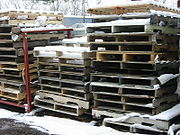
Pallet crafts
Pallet crafts are crafts and projects which use discarded wooden shipping pallets.Wooden pallets are often used for shipping products, but when these get old, they are often thrown away. However, there are many ways to recycle old pallets....
.
Discarded wooden pallets should not be used for fire wood or crafts unless it has been determined that the wood in these pallets has not been treated with wood preservatives, fungicides and/or pesticides. Various pyrethrins and propiconazole are common treatments for wooden pallets. In addition, imported palletized goods are routinely fumigated with highly toxic pesticides. During use, harmful materials or chemicals also may spill on the pallet wood and be absorbed.
Craft publications have advised readers to use pallets to build skateboarding
Skateboarding
Skateboarding is an action sport which involves riding and performing tricks using a skateboard.Skateboarding can be a recreational activity, an art form, a job, or a method of transportation. Skateboarding has been shaped and influenced by many skateboarders throughout the years. A 2002 report...
obstacle called a manual pad, barricades during amateur paintball
Paintball
Paintball is a sport in which players compete, in teams or individually, to eliminate opponents by tagging them with capsules containing water soluble dye and gelatin shell outside propelled from a device called a paintball marker . Paintballs have a non-toxic, biodegradable, water soluble...
games, or other sport-related items. Other publications have suggested using pallet wood for small animal cages or fences. Pallet wood has been recycled for use as furniture wood by at least one company.
The well-known American quality acoustic guitar maker Taylor Guitars
Taylor Guitars
Taylor Guitars is an El Cajon, California‐based luthier, specializing in acoustic guitars, as well as semi-hollow and solidbody electric guitars. It was established in 1974 by Bob Taylor and Kurt Listug.- History :...
famously produced their high quality "pallet guitar" made from pallet wood, in order to demonstrate their prowess and the importance of construction technique versus expensive exotic woods. "The original pallet guitar was made for fun and to prove a point: we can work with non-traditional wood and still make a great guitar. Oh yeah, and we had fun." - Bob Taylor.
The two Austrian students Andreas Claus Schnetzer and Gregor Pils from the University of Vienna
University of Vienna
The University of Vienna is a public university located in Vienna, Austria. It was founded by Duke Rudolph IV in 1365 and is the oldest university in the German-speaking world...
created a home entitled Pallet house and as the name suggests, reuses pallets to form a modular, energy efficient and affordable housing. The idea was born in 2008 during a competition and the Pallet house has been exhibited in several European cities including Venice, Vienna, Linz and Grenoble. It could become a clever approach to low income housing.
Items made from pallet wood are likely to be durable and demonstrate good weather resistance due to these treatments. However, close contact with pallet wood or inhalation of dusts from sanding or sawing can be a source of exposure to pesticide and fungicide chemicals. It is likely that the January, 2010 recall of Johnson and Johnson Tylenol[TM] and other drugs were due to their being stored on wooden pallets that had been treated with the fungicide/pesticide 2,4,6-tribromophenol. This chemical can be degraded by molds to produce 2,4,6-tribromoanisole whose strong, musty odor caused consumers to complain. There is no acute or chronic health data on 2,4,6-tribromoanisole, but it is believed that the contaminated drugs caused nausea and other health effects in some people.
Mean Pallet
A useful barometer to worldwide economic activity, the mean pallet describes a best estimate of the average location of all pallets, both laden and empty, across the planet. Although generally confined to analysis in logisticsLogistics
Logistics is the management of the flow of goods between the point of origin and the point of destination in order to meet the requirements of customers or corporations. Logistics involves the integration of information, transportation, inventory, warehousing, material handling, and packaging, and...
research, the measure is increasingly being used due to the ongoing evolution of computer processing speed and the ability to carry out calculations with ever increasing speeds of data input.
The Mean Pallet has been estimated since the early 1960s. Initially, the estimate placed the Mean Pallet over the Eastern Mediterranean just south of Marmaris in Turkey. However, it is currently located above the Dead Sea
Dead Sea
The Dead Sea , also called the Salt Sea, is a salt lake bordering Jordan to the east and Israel and the West Bank to the west. Its surface and shores are below sea level, the lowest elevation on the Earth's surface. The Dead Sea is deep, the deepest hypersaline lake in the world...
and moving south east with an average velocity of 0.24 km/day. This eastward movement has been attributed to the higher than average economic growth of the Tiger Economy
Tiger Economy
A tiger economy is the economy of a country which undergoes rapid economic growth, usually accompanied by an increase in the standard of living. The term was initially used for Japan, South Korea, Singapore, Hong Kong, and Taiwan , and in the 1990s it was applied to the Republic of Ireland...
countries.
Fire hazards
Both wood and plastic pallets are possible fire hazards. The National Fire Protection AssociationNational Fire Protection Association
The National Fire Protection Association is a United States trade association that creates and maintains private, copywrited, standards and codes for usage and adoption by local governments...
requires that both types "shall be stored outside or in a detached structure" unless protected by fire sprinklers.
Food safety risks
Wood pallets used to transport food can possibly harbor pathogens such as E. coliEscherichia coli
Escherichia coli is a Gram-negative, rod-shaped bacterium that is commonly found in the lower intestine of warm-blooded organisms . Most E. coli strains are harmless, but some serotypes can cause serious food poisoning in humans, and are occasionally responsible for product recalls...
and Listeria.
A release by the National Consumers League
National Consumers League
The National Consumers League, founded in 1899, is an American consumer organization. The National Consumers League is a private, nonprofit advocacy group representing consumers on marketplace and workplace issues....
announced the testing of 70 wood pallets and 70 plastic pallets that have been loaded with perishable products and shipped to an end user was shipped overnight to an independent microbiology lab for testing. The results came back with 10 percent of the wood pallets positive for E. coli and 1.4 percent positive on the plastic pallets.
See also
- 463L master pallet463L master palletThe HCU-6/E or 463L Master Pallet is a standardized pallet used for transporting military air cargo. It is the main air-cargo pallet of the United States Air Force, designed to be loaded and offloaded on today's military airlifters as well as many civilian Civil Reserve Air Fleet cargo...
, a wood and aluminium air cargo pallet primarily used by the US Air Force. - CHEPCHEPCHEP is an international company dealing in pallet and container pooling services, serving customers in a range of industrial and retail supply chains. CHEP is owned by Brambles Limited....
, Commonwealth Handling Equipment Pool - Bulk box
- Concrete block
- Crane (machine)Crane (machine)A crane is a type of machine, generally equipped with a hoist, wire ropes or chains, and sheaves, that can be used both to lift and lower materials and to move them horizontally. It uses one or more simple machines to create mechanical advantage and thus move loads beyond the normal capability of...
- Forklift truckForklift truckA forklift is a powered industrial truck used to lift and transport materials. The modern forklift was developed in the 1920s by various companies including the transmission manufacturing company Clark and the hoist company Yale & Towne Manufacturing...
- ISPM 15ISPM 15International Standards For Phytosanitary Measures No. 15 is an International Phytosanitary Measure developed by the International Plant Protection Convention that directly addresses the need to treat wood materials of a thickness greater than 6mm, used to ship products between countries...
, Regulation of wood packaging material in international trade - International Plant Protection ConventionInternational Plant Protection ConventionThe International Plant Protection Convention is an international treaty organization that aims to secure coordinated, effective action to prevent and to control the introduction and spread of pests of plants and plant products. The Convention extends beyond the protection of cultivated plants to...
Dictates ISPM 15 (above) - Molded pulpMolded pulpMolded pulp, also named Moulded pulp or Molded Fibre, is a packaging material, typically made from recycled paperboard and/or newsprint. It is used for protective packaging or for food service trays and beverage carriers...
pallet - Packaging and labeling
- Pallet invertersPallet invertersA pallet inverter or pile turner is a machine that is used to turn over pallets whilst still loaded with products. The reasons for needing to turn over a pallet are varied, but one main reason is the need to replace a broken or inappropriate pallet without unstacking the whole load. Sometimes a...
- PalletizerPalletizerright|thumb|250px|Palletizer using roboticsA palletizer or palletiser is a machine which provides automatic means for stacking cases of goods or products on to a pallet. The first palletizer was designed, built, and installed in 1948 by a company formerly known as Lamson Corp. There are specific...
- Slip sheetSlip SheetSlip sheets are thin pallet-sized sheets made of plastic, heavy laminated kraft paperboard, or corrugated fiberboard used in commercial shipping. Often, these replace the use of traditional wooden pallets...
- StillageStillageA stillage is like a pallet or skid but with a cage or sides or some form of support specifically tailored to the material it is intended to carry. Some are designed to be stackable....
, a stackable pallet-like device with sides or a cage to contain the load. - Stretch wrapStretch wrapStretch wrap or stretch film is a highly stretchable plastic film that is wrapped around items. The elastic recovery keeps the items tightly bound...
- ULDUnit Load DeviceA unit load device , is a pallet or container used to load luggage, freight, and mail on wide-body aircraft and specific narrow-body aircraft. It allows a large quantity of cargo to be bundled into a single unit. Since this leads to fewer units to load, it saves ground crews time and effort and...
, lightweight aluminium and plastic pallet or container for aircraft. - Unit LoadUnit loadA unit load combines individual items or items in shipping containers into a single "unit" that can be moved easily with pallet jack or forklift truck...
Further reading
- Brody, A. L., and Marsh, K, S., "Encyclopedia of Packaging Technology", John Wiley & Sons, 1997, ISBN 0-471-06397-5
- ASTM D 1185 Test Methods for Pallets and Related Structures
- ASTM D6253 Treatment and/or Marking of Wood Packaging Materials
- Why Use Two If One Will Do?, Palletizer Magazine, 1944
- What Came First, The Pallet or the Forklift?
- An Inspection Guide for the Construction and Inspection of Wood Pallets, U.S. Navy, 1954

